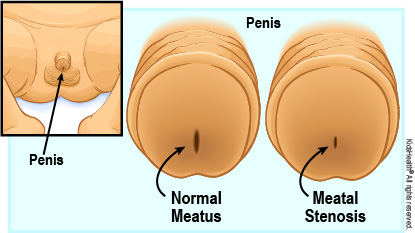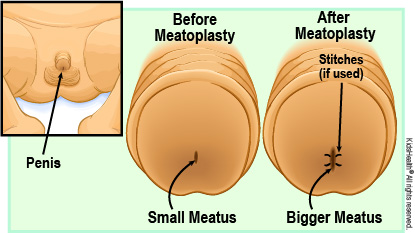Meatal Stenosis: How to Care for Your Child
The meatus (mee-AY-tus) is the opening in a boy's penis where the urine (pee) comes out. In meatal stenosis (mee-ATE-ul steh-NO-sis), the meatus is too small.
Meatal stenosis is usually noticed when a boy starts to toilet train and has trouble aiming his pee into the toilet. Meatal stenosis can cause a boy to pee upward, need to pee a lot, or take a long time to get all of the pee out. Sometimes a boy may feel burning when peeing and, rarely, may see a drop of blood in his underwear.
The treatment for meatal stenosis is called a meatotomy or a meatoplasty. It is a simple procedure to make the opening of the meatus bigger.
A child gets medicine so he will not feel pain during the procedure. Health care providers might use medicine to numb the penis or give general anesthesia to help the child sleep during the procedure.
The procedure fixes meatal stenosis for most boys.


-
Usually, no special home care is needed. Talk to your health care provider if you have any questions.
-
If a meatotomy or meatoplasty is scheduled:
-
Ask the health care provider if your son's regular medicines can be given as usual or if any should be stopped before the procedure.
-
Follow instructions about stopping eating and drinking if general anesthesia is planned.
-
Keep any follow-up appointments as recommended.


Your son:
-
has pain when peeing
-
finds it harder to pee


What causes meatal stenosis? Meatal stenosis can happen when irritation causes a scar to form at the meatus. This makes the opening smaller. The irritation may come from rubbing against a diaper, an injury to the penis, or having a catheter (a plastic tube that lets the pee flow out of the body) in place for a long time. Meatal stenosis is more likely to happen in boys who are circumcised.